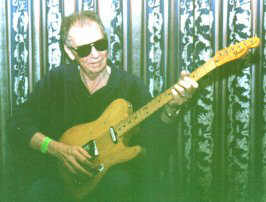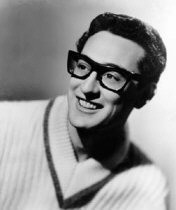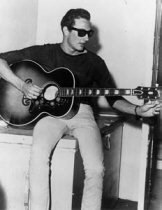|
In May of 2002 rockabilly singer Sonny West played at
Hemsby Rock 'n' Roll Festival. Back in the mid 50's Sonny
recorded his song "Rock-Ola Ruby", which was only
a local US hit, but has become a most popular standard in
Europe. Taking the opportunity to talk to Sonny, he told
me about his friendship with Waylon Jennings and how he
came to co-write two of Buddy Holly's biggest hits.
"Starting in 1956 I met both Waylon and Buddy.
If I had ever run into them before then I didn't know it,
because we were not in the same business." Sony had
gone to Memphis in early 1956 to see Mr Sam Phillips of
Sun Records, but got a pretty negative response due to Phillips
having so many people coming in to record. "My sister
lived close to Lubbock, Texas. I called her up and she said
I could come over there, because I had spent all my money
and was broke. I still had my car and got as far as Fort
Worth, which is a couple of hundred miles from there. (laughs)
I called her up and she wired me some money through Western
Union to get over there to her place."
Sonny's family didn't readily accept his working in
the music business. "Her husband Mr Anderson pretty
well took a liking to me, of course he was always fond of
music...country music, he grew up with that. So I found
a home for a few months  there." there."
Looking around for somewhere to do some recording, Sonny
West managed to get a little recording time at the AM station
KLVT, Levelland, Texas. "They had one of those 15 IPS
slap Echo that they used for commercials. That way I could
go in with just a guitar and vocals and could make something,
kinda like I wanted. Of course I was just doing those demos
and stuff." One of the DJs there (Bob Kaliff) had a
regular show and began playing Sonny's recordings on air.
"He started getting a few phone calls from listeners
and for a laid-back community like that...to get a few phone
calls about somebody's songs was pretty different and gave
me a little encouragement."
Looking for somewhere to make a commercial recording,
Sonny got in touch with Norman Petty in Clovis. "My
brother-in-law backed me up to get a session going in Clovis.
We talked to Norman to arrange the session, but he didn't
like the taped Echo. I tried to get him to do that, but
he wouldn't do it. So I told him that I wanted something
to give it the ambiance. So he said 'I'll see if I can get
you in the theatre after they close'. The Lyceum Theatre
in Clovis, was built by one of the big movie companies such
as United Artistes. As the building had perfect acoustics
it was here that "Rock-Ola Ruby" was recorded.
From the age of 12, Waylon Jennings gained a job as
a pop DJ at a radio station in  his
hometown of Littlefield, Texas. His father played guitar
in Texas dance halls and by his teens, Waylon could play
guitar and sometimes played backup with local bands. One
time when Sonny was coming back from Clovis he stopped by
at the station (Littlefield is on the highway between Clovis
and Lubbock) and Waylon asked him to do a song on air. "I
think it was just me with a guitar and a drummer did the
song on the air. At that time I didn't realise that Waylon
was interested in doing music himself...he'd never expressed
it to me!" Waylon and Sonny struck up a close friendship
and later on Waylon moved to the radio station KLLL at Lubbock.
"Whenever I went to visit him over there he always
had his guitar with him. When he was playing records on
air, he would play along. Oh, he had to show you everything
that he learned. I thought, well this guy is going to be
a big singer someday. He was playing around Lubbock opening
shows with a couple of guys." his
hometown of Littlefield, Texas. His father played guitar
in Texas dance halls and by his teens, Waylon could play
guitar and sometimes played backup with local bands. One
time when Sonny was coming back from Clovis he stopped by
at the station (Littlefield is on the highway between Clovis
and Lubbock) and Waylon asked him to do a song on air. "I
think it was just me with a guitar and a drummer did the
song on the air. At that time I didn't realise that Waylon
was interested in doing music himself...he'd never expressed
it to me!" Waylon and Sonny struck up a close friendship
and later on Waylon moved to the radio station KLLL at Lubbock.
"Whenever I went to visit him over there he always
had his guitar with him. When he was playing records on
air, he would play along. Oh, he had to show you everything
that he learned. I thought, well this guy is going to be
a big singer someday. He was playing around Lubbock opening
shows with a couple of guys."
Sonny first met Buddy Holly at a radio station in Lubbock
around June 1956. "I don't remember if it was the Crickets
that were with him or if Jack Neal was with him. He was
at KDAV Radio and they had a show with open mike on Sunday
(Sunday Party). If they approved of you, they let you do
a song or two.(laughs) I remember Buddy was there and when
he got through, I went into the studio and did a couple
of songs. That was actually how I became acquainted with
Buddy and after that we both started recording in Clovis".
Sonny West teamed up with Bill Tilghman and wrote "Oh
Boy" and "Rave On" which were both recorded
by Buddy Holly. "Bill lived in Levelland where I was
living. It's a small town...word gets around. He knew that
I had this song out, "Rock-Ola Ruby". I was actually
going down the street one day and he stopped me. He yelled
at me in the street to stop me and he came over and introduced
himself. He reached back into his hip pocket and pulled
out a bunch of papers. He had written some stuff down on
the papers...he liked to mess around writing songs. They
were words and he had some sort of idea as to what sort
of tune he wanted with it. But usually he would pick out
a tune that was already written and try to write the words
to that. So we kinda struck up a friendship and would go
over to the bootleggers and get a six-pack of beer once
in a while. And that was how we started writing out."
Sonny and Bill wrote "Oh Boy", which was recorded
by Buddy Holly and The Crickets  which
made #3 on the British charts in December 1957 following
their #1 hit "That'll Be The Day" in September
that same year. "Our biggest song "Oh Boy"
was actually that was my song. The way that worked out...he
kept saying, 'well, we should be partners in all this stuff.'
And when you're a young kid you go along with it. Also you
say...you know with something like that...if it works out.
If we ever gets big and famous...you have your part back,
things like that. You know that even happened with Paul
and John! They traded songs and there was a little kinda
bad feeling, because on got a little bit more recognition
than the other one." which
made #3 on the British charts in December 1957 following
their #1 hit "That'll Be The Day" in September
that same year. "Our biggest song "Oh Boy"
was actually that was my song. The way that worked out...he
kept saying, 'well, we should be partners in all this stuff.'
And when you're a young kid you go along with it. Also you
say...you know with something like that...if it works out.
If we ever gets big and famous...you have your part back,
things like that. You know that even happened with Paul
and John! They traded songs and there was a little kinda
bad feeling, because on got a little bit more recognition
than the other one."
Sonny recorded a demo of "Oh Boy" in 1957,
but it was never released until this year (2002) when Sonny
included it on his current album. "During that time
I didn't have any idea that the song would go anywhere.
You know it's been said that I wrote the song for Buddy...it's
been said that I was trying to get Fats Domino to do it.
The whole truth of the matter was that I wanted the song
for myself, but I just could not get that going! I sent
the record off to a few people to try and get some action.
I didn't care what kind of action...I actually would have
wanted to record it myself with the proper background and
everything...but it just didn't work that way! As the Gods
arranged it...however that happens. Buddy's record with
the Crickets, "That'll Be The Day" had busted
out big. Buddy had already recorded "Oh Boy" in
July. Norman Petty overdubbed the background vocals with
the Picks and they made a beautiful sound. Those guys were
good!
At the time they had already talked to me about recording
the song, but I had not actually got back to them, nor them
with me and I didn't know about this. About the time "That'll
Be The Day" was right at the top of the charts, Norman
called me and said ' we want to release your song as a follow-up
to "That'll Be The Day". I said Gollyyy! Really!
(laughs) I'd been rocking along there, trying to figure
out what direction I was going in, and I didn't even know
some of this stuff was happening. It was a finished product
before I even heard it. Then I went over to Clovis and got
to listen to it, just a few days before it was released"
Sonny was still trying to get his own recording career
into first gear. "I was working on "Rave On"
when we signed the contracts for "Oh Boy". We'd
been working on "Rave On" for a while..."Rave
On" was a harder song to write. We started out going
in a different direction with it and it kind of evolved
into the song that it is today. We had changed it quite
a lot. One time I took it over, and was going to do a demo
at Clovis, just myself and the guitar. I was still looking
for that kind of echo or something to give it that little
bit more excitement. Anyhow, Norman said 'No! That's not
going to work'. He wouldn't even record it....he stopped
me about half way through the song...he wouldn't even let
me listen to whatever he had recorded...I guess he erased
it or something. So we went home and worked on it a while...worked
on something else."
Sonny arranged to record and release "Rave On"
with a Mr Oliver...the man behind one of Roy Orbison's first
recordings, The Teen Kings. A few days before the completion
of the agreement, Norman Petty called to say that he had
a band out of Dallas that he wanted Sonny to record "Rave
On" with. "Norman acted like he could get me a
contract...which he eventually did with Atlantic and I thought
at the time that it was the best way to go. I don't know
if it was the correct decision to make...I wasn't satisfied
with the "Rave On" record with the Big Beats.
They were resident musicians out at Norman's place for a
while and he was trying to get them some work."
When Buddy picked up on the song, he arranged the song
much as Sonny had visualised it. "It was more inline with the thumping
background. Instead of a booming background that we had
with the Big Beats, bass and saxophone. The way Buddy did
it in New York with real professional people. It was slower
than mine. It has more feeling...the kind of feeling that
it should have had. I don't think anyone could have done
it any better than that at the time. Those guys back in
New York who played on it added a few cords in between the
normal cords. They did pop and jazz They did the song good.
You could tell it was a good song, although it was not great
in the States, it was good, but it had a very short life
in the States, because the record buyers in the States were
not head over heals with that style at that time. They were
going more for the Frankie Avalon or somebody like that"
visualised it. "It was more inline with the thumping
background. Instead of a booming background that we had
with the Big Beats, bass and saxophone. The way Buddy did
it in New York with real professional people. It was slower
than mine. It has more feeling...the kind of feeling that
it should have had. I don't think anyone could have done
it any better than that at the time. Those guys back in
New York who played on it added a few cords in between the
normal cords. They did pop and jazz They did the song good.
You could tell it was a good song, although it was not great
in the States, it was good, but it had a very short life
in the States, because the record buyers in the States were
not head over heals with that style at that time. They were
going more for the Frankie Avalon or somebody like that"
"Rave On" was scheduled for cutting in New
York on 26 January 1958. Norman Petty says, "It was
a real hillbilly number, brought to me by Sonny West and
Bill Tilghman. I was playing the tape in the control room
and Buddy came in and said. "I rather like that melody,
but it's a real hillbilly thing". So I said "Would
you like to do it if we changed the lyrics?" So Buddy
said, "Sure" As this was not a Clovis session
(and rather hurried one at that), the opportunity for recording
the background voices later was lost, and the recording
was all done together in only a couple of takes. "Rave
On" made #5 on the British charts the following June.
|


![]()